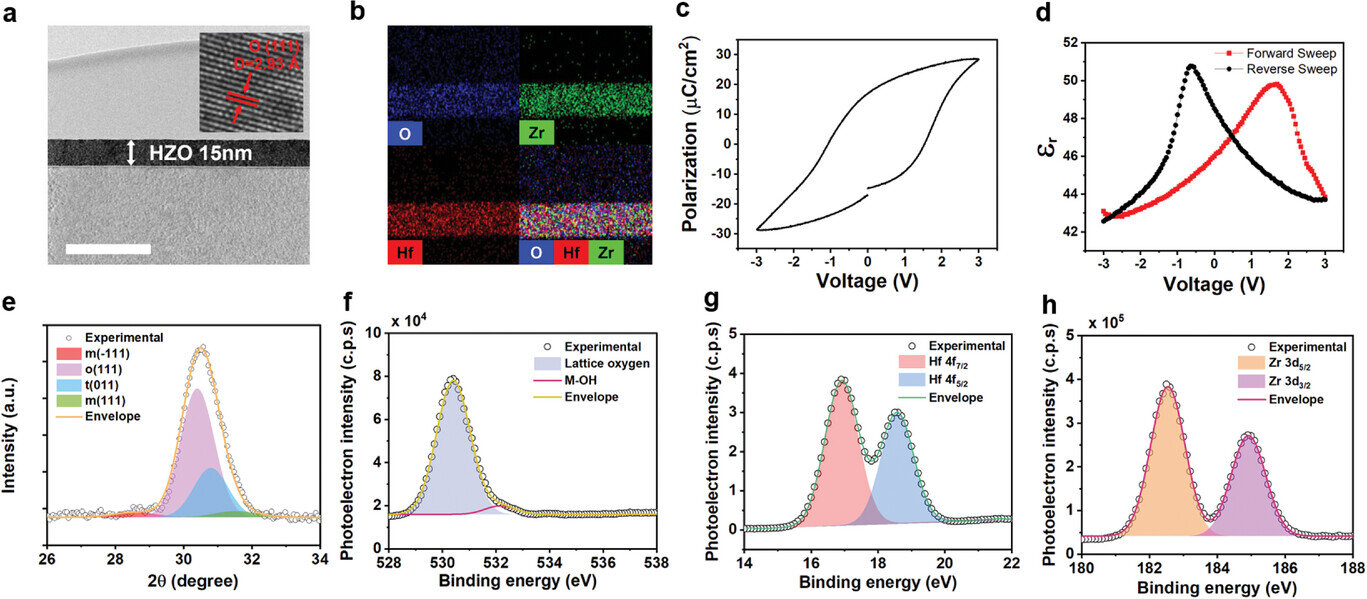![Characteristics of the deposited ferroelectric HZO film. a) HR-TEM image showing the thickness (15 nm) of the ferroelectric HZO film and cross-sectional image of orthorhombic HZO crystallite using HR-TEM. Scale bar, 50 nm. The inset shows a magnified view of the atomic arrangement of orthorhombic HZO [111]. b) EDS mapping of the HZO cross-section, depicting the distribution of the deposited elements (hafnium, zirconium, and oxygen). c) P-V loops of HZO film. d) Permittivity – V loops of HZO film. e) Deconvoluted GIXRD pattern of the ferroelectric HZO film. High-resolution XPS spectra of f) O 1s, g) Hf 4f, h) Zr 3d. Credit: Advanced Science (2024). DOI: 10.1002/advs.202308588 Next-generation artificial intelligence semiconductor devices resembling the human brain](https://scx1.b-cdn.net/csz/news/800a/2024/next-generation-artifi.jpg)
A research team led by Prof. Kwon Hyuk-jun of the DGIST Department of Electrical Engineering and Computer Science has developed a next-generation AI semiconductor technology that mimics the human brain's efficiency in AI and neuromorphic systems.
The advancement of AI has stimulated a rapidly growing demand for energy-efficient semiconductor technology with a fast operational speed. However, traditional computing devices with their von Neumann architecture and separate computing and memory units have speed and energy efficiency shortcomings associated with data processing bottlenecks. Consequently, research on neuromorphic devices that mimic biological neurons' simultaneous computing and memory functions is gaining attention.
Against this backdrop, Prof. Hyuk-Jun Kwon's team developed synaptic field-effect transistors using hafnium oxide, which has strong electrical properties, and thin layers of tin disulfide. This resulted in a three-terminal neuromorphic device capable of storing multiple levels of data in a manner similar to neurons.
The research successfully replicated biological characteristics such as short- and long-term properties, yielding a highly efficient device that responds 10,000 times faster than human synapses and consumes very little energy.
Prof. Hyuk-Jun Kwon of the Department of Electrical Engineering and Computer Science said, "This research marks an important step toward next-generation computing architecture, which requires low power consumption and high-speed computation. We have developed high-performance neuromorphic hardware using two-dimensional channels and ferroelectric hafnium oxide, and the innovation is expected to have various AI and machine learning-related applications in the future."
The research is published in the journal Advanced Science.
More information: Chong‐Myeong Song et al, Ferroelectric 2D SnS2 Analog Synaptic FET, Advanced Science (2024). DOI: 10.1002/advs.202308588
Provided by DGIST (Daegu Gyeongbuk Institute of Science and Technology)
Citation: Next-generation AI semiconductor devices mimic the human brain (2024, March 29) retrieved 29 March 2024 from https://techxplore.com/news/2024-03-generation-ai-semiconductor-devices-mimic.html
This document is subject to copyright. Apart from any fair dealing for the purpose of private study or research, no part may be reproduced without the written permission. The content is provided for information purposes only.
